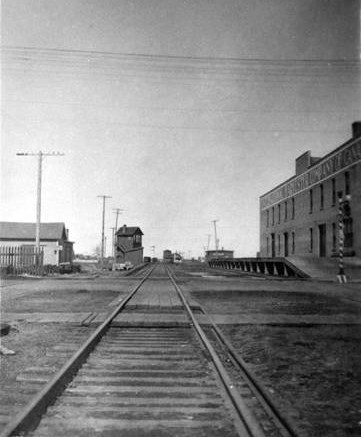Looking North from Broadway Street West. A switch tower was usually located on the right hand side of the track near a track switch, so the engineer who rode in the cab on the right side of the of the locomotive could see signals. This enabled the engineer to switch certain cars or flat beds to a side line in order in facilitate unloading merchandise: machinery, grain etc, or just leave one or more box cars for another train to pick up. A siding is a length of track with switches at each end, used for train meets or passes. A spur track is a stretch of industrial track for storage of cars, engines, etc or sorting as per destination. Long time resident, Ray Riesz tells us “I don’t recall the exact date when the tower was taken down, but I believe it was in the middle to late ‘50’s. This switching tower along with another one located about a mile west of Gladstone Avenue on the CPR line was used to isolate the CPR rail line from the CNR line and vice versa where the two lines crossed. There were large levers in the towers to accomplish the switching. The switching to the sidings was done by the train crews. The switchman would spend long hours in the tower and sometimes during our youthful explorations, my friends and I would visit with him to keep him company.” The building on the right was the International Harvester erected in 1911, demolished in 1993. Frank Korvemaker, Construction Historian in Regina says: “To my knowledge, only one of those towers has survived in Saskatchewan: the Oban Crossing, and it was relocated to the Saskatchewan Railway Museum at Hawker, SW of Saskatoon – being restored in the colour photo below. (see:http://saskrailmuseum.org/index.php/2014/10/)



